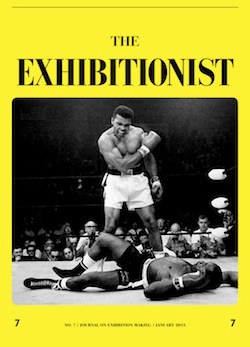The diversity of selections from Iwona Blazwick, Jeffrey Deitch, Norman L. Kleeblatt, Sohl Lee, Suzana Milevska, and Gayatri Sinha demonstrates that the existing literature on exhibition histories has only scratched the surface of a rich field of study. Also for this issue, Carolyn Christov-Bakargiev has given The Exhibitionist a selection of her poems written during the lauded dOCUMENTA (13). These appear as a special insert, providing unique insight into Christov-Bakargiev’s thought processes and reflections.
For “Curators’ Favorites,” Ingrid Schaffner reminisces about Jan Hoet’s Chambres d’Amis in a personal and poetic take on her 1986 journey through art installations in domestic interiors in the city of Ghent, Belgium. Melanie O’Brian takes a second look at the modest exhibition Camera Elinga: Pieter Janssens Meets Jeff Wall at the Städel Museum in Frankfurt in 2002; the unexpected pairing of the Dutch Golden Age painter and the contemporary Canadian photographer proved to her that great things can indeed come in small packages. Miguel Amado analyzes the birth of Tate Modern in 2000 by comparing its innovative (and often controversial) collection display models with its first temporary exhibition, Century City: Art and Culture in the Modern Metropolis.
Zdenka Badovinac reflects on the concept of the local for “Back in the Day” as seen through the spirited efforts of the artist collective Irwin, whose members were so determined to bring a 1983 survey of up-and-coming New York artists to Ljubljana, Slovenia, that they re-created the exhibition themselves. The mirrored and conflicted relationship between the exhibition and the world at large is the subject of this issue’s “Attitude,” in which Terry Smith describes how dOCUMENTA (13) avoided well-worn interpretations of globalization’s effects on contemporary art.
In “Assessments,” four writers tackle the exhibition Indian Highway, curated by Hans Ulrich Obrist and Julia Peyton Jones. Shanay Jhaveri, Geir Haraldseth, Francesco Stocchi, and Carol Yinghua Lueach examine a different iteration of that large-scale national survey, analyzing how context and community, as well as form and content, add meaning to exhibitions. The theme of the traveling exhibition is carried forward in “Typologies,” in which Carlos Basualdo, Susan Hapgood, andHarrell Fletcher give this ever-growing but frequently unexamined format proper analysis.
“Missing in Action” offers a reprint of a 1982 text by Thomas Hoving in which he speaks with an anonymous collector about the latter’s astounding collection and idiosyncratic process for acquiring new works. The two recent exhibitions discussed in “Rear Mirror” both share iconic authors as their starting points. At the British Museum, Dora Thornton actualized Shakespeare’s texts, focusing on the role of the theater in shaping the public’s perception of London and beyond. Janet Bishoprecounts the experience of organizing The Steins Collect, which reunited the collections of Gertrude Stein and her brothers to cement their unique role in the history of Modern art.
The Exhibitionist is a journal made by curators, for curators, focusing solely on the practice of exhibition making. The objective is to create a wider platform for the discussion of curatorial concerns, to encourage a diversification of curatorial models, and to actively contribute to the formation of a theory of curating. It is published by Archive Books and distributed in North America by MIT Press Journals.


